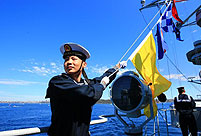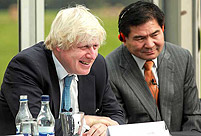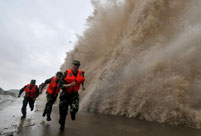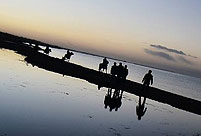BALI, Indonesia, Oct. 8 -- APEC leaders wrapping up a two-day forum pledged here on Tuesday to promote connectivity in the Asia-Pacific and push ahead with free and open trade among the world's most dynamic economies.
To ensure a more efficient flow of goods, services, capital and people, leaders of 21 economies agreed to accelerate physical, institutional and people-to-people connectivity.
"We aspire to achieve a seamlessly and comprehensively connected and integrated Asia Pacific," the leaders said in a joint declaration, vowing to connect regional growth poles, boost transportation networks and reduce transaction costs.
They have laid out a multi-year plan on infrastructure development and investment, noting specific steps to improve supply-chain performance and necessary capacity building of the government.
They have agreed to keep promoting fiscal transparency and public accountability in a bid to foster transparency and competition, and create better functioning markets.
They will also take actions to improve regulation, promote cross-border education, and support global value chain development.
To enhance people-to-people connectivity, the APEC economies endorsed the target of 1 million intra-APEC university-level students per year by 2020, as well as further efforts to enhance the mobility of students, researchers and education providers.
They agreed to progress work on the Travel Facilitation Initiative to promote tourism and facilitate business, and develop youth programs in APEC to foster a sense of community and shared responsibility.
Meanwhile, the leaders also pledged support for the multilateral trading system and efforts to achieve the Bogor Goals of free and open trade and investment by 2020.
All leaders of the APEC economies acknowledged that trade and investment are critical for better jobs and greater prosperity of their people.
They agreed to take steps to reduce tariffs on environmental goods, boost rural development, and encourage more private investment.
The APEC is an economic forum in the Asia-Pacific region established in 1989. It currently has 21 members and aims to facilitate free trade and investment in the region.
 2013 Colour Me Rad 5K run held in Canada
2013 Colour Me Rad 5K run held in Canada China's destroyer Qingdao sails out of Sydney Harbor
China's destroyer Qingdao sails out of Sydney Harbor Chinese tycoon aims to restore London's Crystal Palace
Chinese tycoon aims to restore London's Crystal Palace A staple of southern Chinese people
A staple of southern Chinese people Typhoon Fitow approaches China
Typhoon Fitow approaches China Tourists take pictures beside Qinghai Lake in Xining
Tourists take pictures beside Qinghai Lake in Xining New couples take wedding photos during holiday
New couples take wedding photos during holiday Serena Williams stumbles through to quarterfinals
Serena Williams stumbles through to quarterfinals Thailand Mobile Expo 2013 kicks off
Thailand Mobile Expo 2013 kicks off Photo collection of Chinese Navy
Photo collection of Chinese Navy Dense haze envelops N China
Dense haze envelops N China Twins Culture Festival kicks off in Beijing
Twins Culture Festival kicks off in Beijing UNESCO world heritage site: Montale Tower
UNESCO world heritage site: Montale Tower Egyptian protesters clash with police amid war anniv. celebration
Egyptian protesters clash with police amid war anniv. celebration Serena Williams wins second China Open title
Serena Williams wins second China Open titleDay|Week|Month